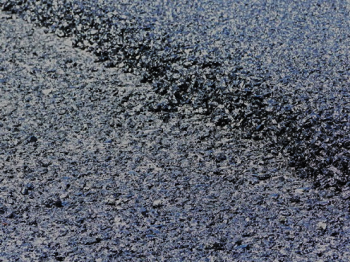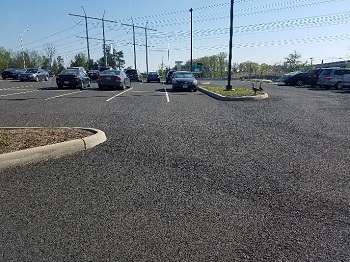Performance of VDOT’s First Porous Pavement Park and Ride
Print this Article | Send to Colleague
In 2013, VDOT constructed its first porous pavement park and ride. Located off Cushing Road in Prince William County, this project incorporated a pavement design that was different from past porous pavements constructed in Virginia. First, previous projects included the use of a choker layer (AASHTO #8’s or #57’s) on top of the thick aggregate reservoir. The purpose of the choker layer was to help stabilize the larger stone layer (AASHTO #2’s/#3’s), to aid in paving. When used on previous projects, only one layer of porous asphalt was laid. However, with two lifts of porous asphalt being used, the choker layer was eliminated. As just mentioned, new to this project was the use of multiple lifts of porous asphalt materials – PAM-9.5 and PAM-19.0. The layer of PAM-19.0 was used to level the site and provide a stable foundation for the surface lift of PAM-9.5 (see Figure 1). Finally, the PAM-9.5 used a PG 76-22 binder to improve performance and minimize power steering scuffing.

Figure 1 - PAM-9.5 laid on PAM-19.0
Since the initial construction of the project, the pavement has been monitored visually by interested parties as well as serving as part of a research project conducted by Fitch and Bowers. This report is available through the VAA and VTRC websites. The research focused on two areas: 1) the impacts of maintenance actions on infiltration and the length of time a porous pavement could serve as a stormwater best management practice and 2) the differences in stiffness between the PAM-9.5 and PAM-19.0 due to the high air void contents.
In the past five years, raveling of the PAM-9.5 material has been noted (Figure 2) and attributed to the low production temperatures of the mix and the use of PG 76-22. It is surmised that the mix was too cool and prevented proper adhesion during the rolling process. Areas where additional handwork was needed raveled more than other areas. Again, these areas were very cool before compaction. Since this project was constructed, the specification has been revised to increase the production temperature of the mix. No other failures have been recorded in the parking lot other than minimal raveling. As discussed in the research report, the infiltration has decreased, but the values are still much greater than the minimum required.

Figure 2 - Minor Surface Raveling @ Year 5
Overall, this innovative pavement structure has proven to be effective. Today, porous pavement parking lots are used as a best management practice. In the future, these structures can be designed and constructed for lower volume routes in Virginia as they have been done in other states.
